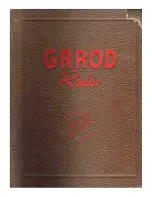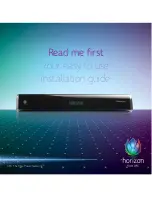
Rechargeable Lithium-ion Battery
This receiver uses a rechargeable Lithium-ion bat-
tery.
WARNING
-
Do not damage the rechargeable Lithi-
um-ion battery. A damaged battery can cause an ex-
plosion or fire, and can result in personal injury
and/or property damage. To prevent injury or dam-
age:
•
Do not use or charge the battery if it appears
to be damaged. Signs of damage include, but
are not limited to, discoloration, warping, and
leaking battery fluid.
•
Do not expose the battery to fire, high tem-
perature, or direct sunlight.
•
Do not immerse the battery in water.
•
Do not use or store the battery inside a vehicle
during hot weather.
•
Do not drop or puncture the battery.
•
Do not open the battery or short-circuit its con-
tacts.
WARNING
-
Avoid contact with a rechargeable Lith-
ium-ion battery if it appears to be leaking. Battery
fluid is corrosive, and contact with it can result in
personal injury and/or property damage. To prevent
injury or damage:
•
If a battery leaks, avoid contact with the bat-
tery fluid.
•
If battery fluid gets into your eyes, immediate-
ly rinse your eyes with clean water and seek
medical attention. Do not rub your eyes!
•
If battery fluid gets onto your skin or clothing,
immediately use clean water to wash off the
battery fluid.
WARNING
-
Charge and use the rechargeable Lith-
ium-ion battery only in strict accordance with the
instructions. Charging or using the battery in unau-
thorized equipment can cause an explosion or fire,
and can result in personal injury or/and equipment
damage. To prevent injury or damage:
•
Do not charge a battery if it appears to be dam-
aged or leaking.
•
USE EXCLUSIVELY the dual-battery charger
(P/N 53018010-SPN) with the AC/DC power
block (model ADP-65JH AB, P/N 78650) to
charge the SP60 Lithium-ion battery. See in-
structions in this guide. These two devices are
part of the SP60 standard accessories list.
CHARGE THE BATTERY ONLY IN THE TEM-
PERATURE RANGE 0° to +40°C (32° to
104°F), at a maximum altitude of 2,000 me-
ters (6,562 feet).
•
Discontinue charging a battery that gives off
extreme heat or a burning odor.
•
Use the battery only in Spectra Precision
equipment that is specified to use it.
•
Use the battery only for its intended use and
according to the instructions in the product
documentation.
Disposing of Rechargeable Lithium-ion Battery
Discharge Lithium-ion battery before disposing of
it. When disposing of a battery, be sure to do so in
an environmentally sensitive manner. Adhere to any
local and national regulations concerning battery
disposal or recycling.
Receiver Use and Care
The receiver can withstand the rough treatment
that typically occurs in the field. However, the re-
ceiver is a high-precision electronic instrument and
should be treated with reasonable care.
CAUTION
- Operating or storing the receiver out-
side the specified temperature range can damage
it. For more information, see Physical Specifica-
tions in this guide.
High-power signals from a nearby radio or radar
transmitter can overwhelm the receiver circuits.
This does not harm the instrument, but it can pre-
vent the receiver from functioning correctly. Do not
use the receiver within 400 meters (1312 feet) of
powerful radar, television or other transmitters.
Low-power transmitters such as those used in cell
phones and two-way radios do not normally inter-
fere with receiver operations.
For more information, contact your Spectra Preci-
sion distributor.
Bluetooth Radio
The radiated output power of the wireless radio is
far below the FCC radio-frequency exposure limits.
Nevertheless, the wireless radio shall be used in
such a manner that the Spectra Precision receiver
is 20 cm or further from the human body.
The internal wireless radio operates within guide-
lines found in radio-frequency safety standards and
recommendations, which reflect the consensus of
the scientific community. Spectra precision there-
fore believes the internal wireless radio is safe for
use by consumers.
The level of energy emitted is far less than the elec-
tromagnetic energy emitted by wireless devices
such as mobile phones. However, the use of wire-
less radios may be restricted in some situations or
environments, such as on aircraft. If you are unsure
of restrictions, you are encouraged to ask for autho-
rization before turning on the wireless radios.
COCOM Limits
The US Department of Commerce requires that all
exportable GNSS products contain performance
limitations so that they cannot be used in a manner
that could threaten the security of the United
States.
The following limitation is implemented on the re-
ceiver: Immediate access to satellite measure-
ments and navigation results is disabled when the
receiver’s velocity is computed to be greater than
1000 knots, or its altitude is computed to be above
17,000 meters (59,055 feet). The receiver contin-
uously resets until the COCOM situation is cleared.
Technical Assistance
If you have a problem and cannot find the informa-
tion you need in the product documentation, con-
tact your local distributor. Alternatively, request
technical support using the Spectra Precision web-
site at
www.spectraprecision.com
.
Your Comments
Your feedback about the supporting documentation
helps us improve it with each revision. Email your
comments to
documentation_feedback@spectra-
precision.com
.




































